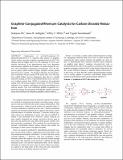Graphite-Conjugated Rhenium Catalysts for Carbon Dioxide Reduction
Author(s)
Oh, Seokjoon; Gallagher, James R.; Miller, Jeffrey T.; Surendranath, Yogesh
DownloadReGCC_Revision_Final.pdf (1.974Mb)
PUBLISHER_POLICY
Publisher Policy
Article is made available in accordance with the publisher's policy and may be subject to US copyright law. Please refer to the publisher's site for terms of use.
Terms of use
Metadata
Show full item recordAbstract
ondensation of fac-Re(5,6-diamino-1,10-phenanthroline)(CO)₃Cl to o-quinone edge defects on graphitic carbon surfaces generates graphite-conjugated rhenium (GCC-Re) catalysts that are highly active for CO₂ reduction to CO in acetonitrile electrolyte. X-ray photoelectron and X-ray absorption spectroscopies establish the formation of surface-bound Re centers with well-defined coordination environments. GCC-Re species on glassy carbon surfaces display catalytic currents greater than 50 mA cm⁻² with 96 ± 3% Faradaic efficiency for CO production. Normalized for the number of Re active sites, GCC-Re catalysts exhibit higher turnover frequencies than that of a soluble molecular analogue, fac-Re(1,10-phenanthroline)(CO)₃Cl, and turnover numbers greater than 12,000. In contrast to the molecular analogue, GCC-Re surfaces display a Tafel slope of 150 mV/decade, indicative of a catalytic mechanism involving rate-limiting one-electron transfer. This work establishes graphite-conjugation as a powerful strategy for generating well-defined, tunable, heterogeneous electrocatalysts on ubiquitous graphitic carbon surfaces.
Date issued
2016-01Department
Massachusetts Institute of Technology. Department of ChemistryJournal
Journal of the American Chemical Society
Publisher
American Chemical Society (ACS)
Citation
Oh, Seokjoon et al. “Graphite-Conjugated Rhenium Catalysts for Carbon Dioxide Reduction.” Journal of the American Chemical Society 138, 6 (February 2016): 1820–1823 © 2016 American Chemical Society
Version: Author's final manuscript
ISSN
0002-7863
1520-5126